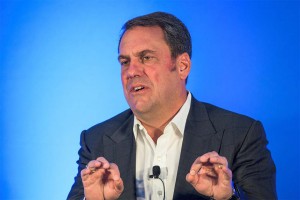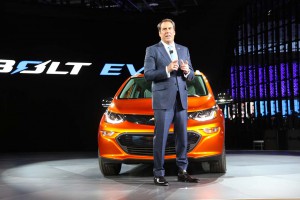
GM’s Mark Reuss told an audience in Detroit last night that the company plans to remain in the passenger car business.
Unlike some of its competitors, General Motors has no plans to pull out of parts of the passenger car business, GM Executive Vice President Mark Reuss told the annual Automotive News World Congress.
“We really don’t have to,” he said.
Reuss said General Motors global scale allows it to continue building cars in various segments. GM does plan to retire older models that are now sold in more remote markets outside the United States, but they will be replaced by vehicles built from global platforms that serve multiple regions, he said.
GM had announced plans more than two years ago to consolidate and reduce substantially the new of vehicle architectures that it uses as part of the company’s overall efforts to contain costs.
(Autonomous cars could make brands irrelevant, warns Bill Ford. For more, Click Here.)
Reuss also said GM could not have produced the Chevrolet Bolt, which was named the North American Car of The Year this week, without first having developed the Chevrolet Volt 10 years ago.

Mark Reuss said this year’s Car of the Year would not have been possible without the development of the Chevy Volt.
“That journey started as a pretty interesting concept,” he said.
“It was hard for people to understand that we were using an internal combustion engine to charge the batteries. We were building an extended range electric vehicle,” Reuss recalled. “It was one of the toughest stories we had to tell from a sales perspective.
Moreover, GM’s original sales targets for the Volt were unrealistic, which only served to make the job of selling the vehicle more difficult. “They demanded big sales volumes. It’s hard to sell cars,” Reuss noted.
But the Volt has the lowest warranty cost of any vehicle GM has ever built and the automaker could not have built the Bolt, which is an affordable electric vehicle without the knowledge the company gained from developing the Volt.
(Learn more about GM extended warranty options.)
“This business is about the technology,” he said. “Our people really delivered.”
(Click Here to see more about GM’s expectations of improved 2017 earnings.)
Reuss also emphasized that the bankruptcy in 2009 and the ignition-switch failure five years later have led to “enormous culture changes” at GM.
As the ignition switch crisis unfolded, Reuss said he was forced to play detective and trace failures that had occurred years ago.
“I had to open up doors and clean up the mess behind them,” said Reuss, who noted where the automaker has switched from the old silo approach to building cars to a systems approach the stresses teamwork and collaboration, he said. “No one person builds a car,” he noted.
At the same time, Reuss said he is mindful of the morale of the company’s employees. “At the end of day, people need to know what it feels like to win. It’s easy to lose confidence,” he said.
Reuss also said GM gamble of a midsized truck has paid big dividends. A number of factors played into the decision to move ahead with the midsized truck. First Toyota had built a very successful business on the West Coast, selling smaller trucks and for another the cost of full-size trucks was rising steadily, pricing younger buyers out of the market, Reuss noted.
(Click Here for more about Chevy Bolt being named North American Car of the Year.)
“But they’re still compelling vehicles for young people,” said Reuss, who also said he asked for different Chevrolet version of the truck to make it more appealing to younger buyers and to put some distance between it and GM’s full-size pickup trucks.
